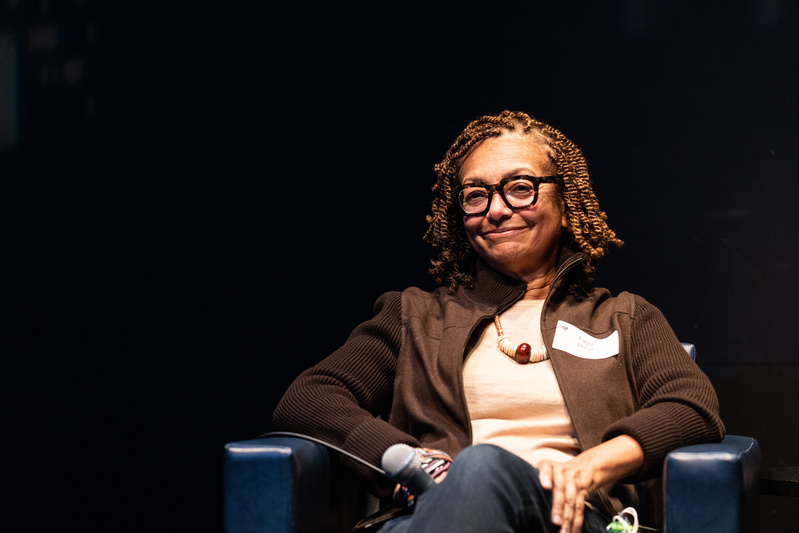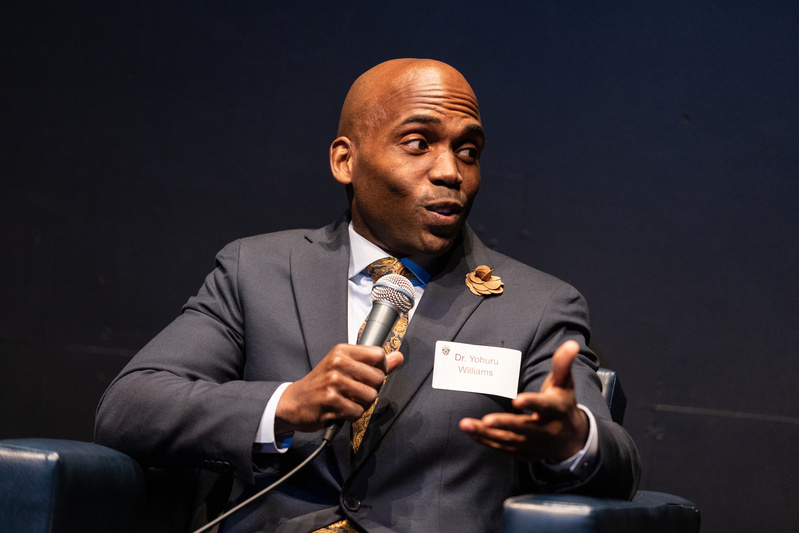There is much that can be learned about life from theatrical plays. The University of St. Thomas showcased that when it brought the topics of racial justice and principled leadership together during an exclusive pre-performance discussion of “Blues for an Alabama Sky” at the Guthrie Theater in Minneapolis.
Dr. Yohuru Williams, history professor and founding director of the university’s Racial Justice Initiative, and Faye Price, dramaturg and veteran of the Twin Cities theater industry, discussed the play’s themes of found family, Black history and resilience, with Maija Garcia, the Guthrie’s director of education and professional training.

One of the themes of the play is the interplay between confronting truths, seeking peace and the consequences of denial. Price and Williams said that dynamic shows up in life when difficult realities require us to live through discomfort.
The evening, attended by St. Thomas corporate partners, students and employees, was sponsored by Target, Ryan Companies and Kowalski’s in partnership with the university’s Melrose and The Toro Company Center for Principled Leadership. It was the second year the center worked with the Guthrie for an exclusive evening for St. Thomas. Last year, Williams led a discussion before a performance of the theater’s production of “A Raisin in the Sun.”
This year’s inspiring discussion revealed a few key takeaways that prefaced the performance of Pearl Cleage’s play:
History is context for the present
“Blues for an Alabama Sky” takes place in Harlem, New York City, nearly 100 years ago. In the 1930s, Harlem was a destination for Black Americans from southern states leaving oppressive societies for more economic and personal freedom. This Great Migration created what is known as the Harlem Renaissance of the 1920s and 1930s, with the flourishing of Black artists, entrepreneurs and religious and political leaders.

“Some of the questions that are raised in the play are very contemporary … some of these subject matters just haven’t changed,” Price said. “The subject matter of homosexuality is very present in the play. The subject matter of birth control is very much in the play. Pearl has done a wonderful job of setting us up to look at the past through the gaze of our present eyes in her 1995 play.”
People on the margins drive change
Among the luminaries of the Harlem Renaissance were Langston Hughes and Countee Cullen, who were gay or did not publicly acknowledge their sexuality. The fact that they were marginalized as Black men, and for their sexuality, adds to the depth of their poetry and writing about liberation, Williams said.
“What gives voice to Langston Hughes or Countee Cullen, it’s the intimate knowledge of what it means to be oppressed – dually,” he said. “What we see in those people who are on the margins of the margins is a powerful desire for liberty.”

Williams drew parallels to this double oppression to the Stonewall uprising of gay men in New York City in 1969, which had a core of Black transgender women behind it, and to Bayard Rustin, an organizer of Martin Luther King Jr.’s 1963 civil rights March on Washington. Rustin was not permitted to have a public role in the protest because of his sexuality.
“It’s Black queer activists who are driving a lot of the activism around challenging inequality because they experience it most acutely,” Williams said. “That’s not to say that straight people aren’t experiencing it and fighting back, they certainly are, but (Black queer people) know it in a way that’s intimate because they can’t escape it.”
The dramaturg brings 1930s Harlem to life

Price gave the audience a window into her work to turn a piece of historical fiction into a living representation of New York City’s Harlem neighborhood at a pivotal moment.
“It was important to know where everyone (in the play) came from,” she said. “Harlem is where all the African American dreamers landed in the 1930s.”
She filled the director and the actors with information about life in the Harlem Renaissance.
Even with all the research, “that wasn’t enough, because artists are curious and we want to be exact in what we’re representing,” she said. “So, if I had an actor ask me, how much did mayonnaise cost in 1930s Harlem, I had to go find out. It was important (for the actors) to know how much was rent, how much was transportation, how much did a doctor make?”
When treating only the most obvious wound
The play’s themes remind us of the history of civil rights and the fight for equality that women and LGBTQ people took up in the late 1960s, into the 1970s, and beyond.
By looking only at racism, and ignoring the harms of homophobia and misogyny, “you find yourself in that 1963 moment where you’ve got Pauli Murray saying to A. Philip Randolph and Martin Luther King Jr., please don’t make this a male-centered March on Washington,” he said. By ignoring women and LGBTQ people at that time, their struggles for equality had to repeat the activism and protest undertaken by Black Americans.”
Learn more about the Racial Justice Initiative and the Melrose and The Toro Company Center for Principled Leadership.






